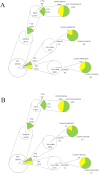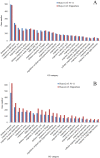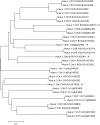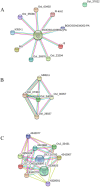Genome wide re-sequencing of newly developed Rice Lines from common wild rice (Oryza rufipogon Griff.) for the identification of NBS-LRR genes
- PMID: 28700714
- PMCID: PMC5507442
- DOI: 10.1371/journal.pone.0180662
Genome wide re-sequencing of newly developed Rice Lines from common wild rice (Oryza rufipogon Griff.) for the identification of NBS-LRR genes
Abstract
Common wild rice (Oryza rufipogon Griff.) is an important germplasm for rice breeding, which contains many resistance genes. Re-sequencing provides an unprecedented opportunity to explore the abundant useful genes at whole genome level. Here, we identified the nucleotide-binding site leucine-rich repeat (NBS-LRR) encoding genes by re-sequencing of two wild rice lines (i.e. Huaye 1 and Huaye 2) that were developed from common wild rice. We obtained 128 to 147 million reads with approximately 32.5-fold coverage depth, and uniquely covered more than 89.6% (> = 1 fold) of reference genomes. Two wild rice lines showed high SNP (single-nucleotide polymorphisms) variation rate in 12 chromosomes against the reference genomes of Nipponbare (japonica cultivar) and 93-11 (indica cultivar). InDels (insertion/deletion polymorphisms) count-length distribution exhibited normal distribution in the two lines, and most of the InDels were ranged from -5 to 5 bp. With reference to the Nipponbare genome sequence, we detected a total of 1,209,308 SNPs, 161,117 InDels and 4,192 SVs (structural variations) in Huaye 1, and 1,387,959 SNPs, 180,226 InDels and 5,305 SVs in Huaye 2. A total of 44.9% and 46.9% genes exhibited sequence variations in two wild rice lines compared to the Nipponbare and 93-11 reference genomes, respectively. Analysis of NBS-LRR mutant candidate genes showed that they were mainly distributed on chromosome 11, and NBS domain was more conserved than LRR domain in both wild rice lines. NBS genes depicted higher levels of genetic diversity in Huaye 1 than that found in Huaye 2. Furthermore, protein-protein interaction analysis showed that NBS genes mostly interacted with the cytochrome C protein (Os05g0420600, Os01g0885000 and BGIOSGA038922), while some NBS genes interacted with heat shock protein, DNA-binding activity, Phosphoinositide 3-kinase and a coiled coil region. We explored abundant NBS-LRR encoding genes in two common wild rice lines through genome wide re-sequencing, which proved to be a useful tool to exploit elite NBS-LRR genes in wild rice. The data here provide a foundation for future work aimed at dissecting the genetic basis of disease resistance in rice, and the two wild rice lines will be useful germplasm for the molecular improvement of cultivated rice.
Conflict of interest statement
Figures







Similar articles
-
Genome-Wide Analysis of Genetic Variations and the Detection of Rich Variants of NBS-LRR Encoding Genes in Common Wild Rice Lines.Plant Mol Biol Report. 2018;36(4):618-630. doi: 10.1007/s11105-018-1103-1. Epub 2018 Jul 22. Plant Mol Biol Report. 2018. PMID: 30363818 Free PMC article.
-
Construction of chromosome segment substitution lines of Dongxiang common wild rice (Oryza rufipogon Griff.) in the background of the japonica rice cultivar Nipponbare (Oryza sativa L.).Plant Physiol Biochem. 2019 Nov;144:274-282. doi: 10.1016/j.plaphy.2019.09.041. Epub 2019 Sep 25. Plant Physiol Biochem. 2019. PMID: 31593900
-
Genome-wide identification of NBS genes in japonica rice reveals significant expansion of divergent non-TIR NBS-LRR genes.Mol Genet Genomics. 2004 May;271(4):402-15. doi: 10.1007/s00438-004-0990-z. Epub 2004 Mar 10. Mol Genet Genomics. 2004. PMID: 15014983
-
[Single nucleotide polymorphism (SNP) and its application in rice].Yi Chuan. 2006 Jun;28(6):737-44. Yi Chuan. 2006. PMID: 16818440 Review. Chinese.
-
Plant nucleotide binding site-leucine-rich repeat (NBS-LRR) genes: active guardians in host defense responses.Int J Mol Sci. 2013 Apr 2;14(4):7302-26. doi: 10.3390/ijms14047302. Int J Mol Sci. 2013. PMID: 23549266 Free PMC article. Review.
Cited by
-
Whole-genome resequencing analysis of 20 Micro-pigs.Genes Genomics. 2020 Mar;42(3):263-272. doi: 10.1007/s13258-019-00891-x. Epub 2019 Dec 12. Genes Genomics. 2020. PMID: 31833050
-
Comparative study of the mycorrhizal root transcriptomes of wild and cultivated rice in response to the pathogen Magnaporthe oryzae.Rice (N Y). 2019 May 10;12(1):35. doi: 10.1186/s12284-019-0287-9. Rice (N Y). 2019. PMID: 31076886 Free PMC article.
-
Genome-Wide Analysis of Genetic Variations and the Detection of Rich Variants of NBS-LRR Encoding Genes in Common Wild Rice Lines.Plant Mol Biol Report. 2018;36(4):618-630. doi: 10.1007/s11105-018-1103-1. Epub 2018 Jul 22. Plant Mol Biol Report. 2018. PMID: 30363818 Free PMC article.
-
A catalog of annotated high-confidence SNPs from exome capture and sequencing reveals highly polymorphic genes in Norway spruce (Picea abies).BMC Genomics. 2018 Dec 17;19(1):942. doi: 10.1186/s12864-018-5247-z. BMC Genomics. 2018. PMID: 30558528 Free PMC article.
-
Differential expression of NBS-LRR-encoding genes in the root transcriptomes of two Solanum phureja genotypes with contrasting resistance to Globodera rostochiensis.BMC Plant Biol. 2017 Dec 28;17(Suppl 2):251. doi: 10.1186/s12870-017-1193-1. BMC Plant Biol. 2017. PMID: 29297325 Free PMC article.
References
-
- Han B, Huang X. Sequencing-based genome-wide association study in rice. Curr Opin Plant Biol. 2013; 16: 133–138. doi: 10.1016/j.pbi.2013.03.006 - DOI - PubMed
-
- Ngu MS, Sabu KK, Lim LS, Abdullah MZ, Wickneswari R. Genetic structure of Oryza rufipogon Griff. natural populations in Malaysia: implications for conservation and genetic introgression of cultivated rice. Tropical Plant Biol. 2010; 3(4): 227–239.
-
- Huang P, Molina J, Flowers JM, Rubinstein S, Jackson SA, Purugganan MD, et al. Phylogeography of Asian wild rice, Oryza rufipogon: a genome-wide view. Mol Ecol. 2012; 21(18): 4593–4604. doi: 10.1111/j.1365-294X.2012.05625.x - DOI - PubMed
-
- Song Z, Li B, Chen J, Lu BR. Genetic diversity and conservation of common wild rice (Oryza rufipogon) in China. Plant Species Biol. 2005; 20(2); 83–92.
-
- Zhao K, Tung CW, Eizenga GC, Wright MH, Ali ML, Price AH, et al. Genome-wide association mapping reveals a rich genetic architecture of complex traits in Oryza sativa. Nat Commun. 2011; 2: 467 doi: 10.1038/ncomms1467 - DOI - PMC - PubMed
MeSH terms
Substances
LinkOut - more resources
Full Text Sources
Other Literature Sources
Research Materials
Miscellaneous

